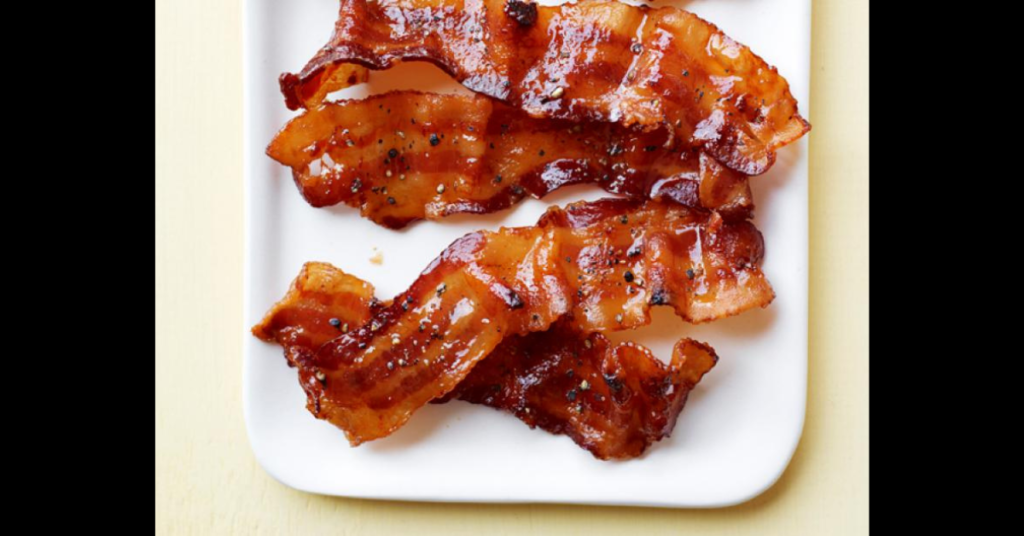Maple bacon’s is a culinary creation that epitomizes the fusion of sweet and savory flavors. By glazing bacon with maple syrup, this dish offers a unique taste experience that combines the smoky, salty essence of bacon with the rich, caramel-like sweetness of maple syrup. This delectable combination has made maple bacon a beloved choice for breakfast enthusiasts and food aficionados alike. In this comprehensive exploration, we will delve into the origins, preparation methods, variations, cultural significance, and nutritional aspects of maple bacon’s.
Origins and Historical Context
The origins of maple bacon’s can be traced back to the broader history of bacon and maple syrup, two ingredients with rich culinary traditions.
Bacon: A Brief History
Bacon has been a staple in human diets for centuries, with its roots stretching back to ancient civilizations. The process of curing pork dates back to 1500 B.C. in China, where pork belly was preserved with salt. This technique eventually spread to Europe and the Roman Empire, where bacon became a favored food due to its long shelf life and rich flavor.
The word “bacon” itself is derived from the Old High German “bacho,” meaning “buttock,” “ham,” or “side of bacon,” and the Old French “bacon.” In medieval England, bacon was commonly made by curing pork bellies with salt, a tradition that continued through the centuries. By the 17th century, bacon had become a staple in American colonial diets, with early settlers bringing their curing techniques to the New World.
Maple Syrup: A Sweet Legacy
Maple syrup has an equally storied past. Indigenous peoples in North America were the first to harvest sap from maple trees and reduce it to a syrupy consistency. They taught European settlers how to tap maple trees, and the tradition of producing maple syrup quickly spread throughout the northeastern United States and Canada.
The process of making maple syrup involves tapping sugar maple trees in the early spring, collecting the sap, and boiling it down to concentrate the sugars. This labor-intensive process results in the rich, amber syrup that has become synonymous with North American breakfasts.
The Fusion of Maple Syrup and Bacon
The combination of maple syrup and bacon likely originated in North America, where both ingredients were readily available and deeply ingrained in regional culinary traditions. While the exact origins of maple bacon are unclear, it is believed that early settlers and farmers, who had access to both bacon and maple syrup, began experimenting with combining these flavors.
The concept of glazing bacon with maple syrup likely emerged as a natural extension of traditional breakfast pairings. Pancakes, waffles, and French toast, often served with bacon and drizzled with maple syrup, provided a natural context for the creation of maple bacon. The smoky-salty bacon, when paired with the sweet maple syrup, offered a harmonious balance of flavors that quickly gained popularity.
Preparation Methods
Creating the perfect maple bacon’s involves a careful balance of technique and ingredients. While the basic concept is simple, there are several methods and variations that can be employed to achieve the desired flavor and texture.
Selecting the Right Bacon
The first step in making maple bacon’s is choosing the right bacon. The quality of the bacon significantly impacts the final result. There are several factors to consider when selecting bacon for this purpose:
- Cut of Bacon: Thick-cut bacon is often preferred for maple bacon because it holds up well to the glazing process and provides a satisfying chew. Thin-cut bacon can also be used, but it may require shorter cooking times to prevent burning.
- Curing Method: Both smoked and unsmoked bacon can be used, depending on personal preference. Smoked bacon adds an extra layer of flavor that complements the maple syrup, while unsmoked bacon allows the sweetness of the syrup to shine.
- Quality and Source: Opt for high-quality, artisanal bacon if possible. Bacon from pasture-raised pigs, free from antibiotics and hormones, often has superior flavor and texture.
Glazing Techniques
There are several methods for glazing bacon with maple syrup, each with its own advantages and nuances. Here are three popular techniques:
- Oven-Baked Maple Bacon:
- Preheat the oven to 400°F (200°C).
- Line a baking sheet with aluminum foil or parchment paper for easy cleanup.
- Place a wire rack on top of the baking sheet to allow the bacon to cook evenly and the fat to drip away.
- Lay the bacon slices on the wire rack in a single layer, ensuring they do not overlap.
- Brush each slice of bacon with maple syrup using a pastry brush.
- Bake in the preheated oven for 15-20 minutes, or until the bacon is crispy and caramelized. Keep a close eye on it to prevent burning.
- Remove the bacon from the oven and let it cool slightly before serving.
- Pan-Fried Maple Bacon:
- Heat a large skillet over medium heat.
- Add the bacon slices to the skillet, ensuring they do not overlap.
- Cook the bacon for 5-7 minutes on each side, or until it reaches the desired level of crispiness.
- During the last few minutes of cooking, drizzle maple syrup over the bacon and continue to cook, flipping the slices occasionally to coat them evenly.
- Once the bacon is caramelized and crispy, transfer it to a paper towel-lined plate to drain excess fat before serving.
- Grilled Maple Bacon:
- Preheat the grill to medium heat.
- Place the bacon slices directly on the grill grates or use a grill pan to prevent sticking.
- Cook the bacon for 3-5 minutes on each side, or until crispy.
- During the last few minutes of grilling, brush maple syrup onto the bacon slices, flipping them to ensure even glazing.
- Remove the bacon from the grill and let it cool slightly before serving.
Variations and Enhancements
While the classic maple bacon’s recipe is delicious on its own, there are numerous variations and enhancements that can elevate this dish to new heights. Here are some creative ideas to inspire your culinary adventures:
Spicy Maple Bacon
For those who enjoy a bit of heat, adding a touch of spice to maple bacon’s can create a delightful contrast. To make spicy maple bacon, simply incorporate one or more of the following ingredients into the maple syrup before glazing the bacon:
- Cayenne Pepper: A pinch of cayenne pepper adds a subtle heat that complements the sweetness of the maple syrup.
- Crushed Red Pepper Flakes: For a more pronounced spiciness, sprinkle crushed red pepper flakes onto the bacon after glazing.
- Sriracha: Mixing a small amount of Sriracha sauce with the maple syrup creates a tangy, spicy glaze.
Candied Maple Bacon
Candied maple bacon’s takes the sweetness to the next level by incorporating brown sugar into the glaze. This variation is perfect for those with a sweet tooth. To make candied maple bacon:
- Mix equal parts maple syrup and brown sugar in a small bowl.
- Brush the mixture onto the bacon’s slices before baking or frying.
- The brown sugar will caramelize during cooking, creating a sweet, crunchy coating on the bacon.
Maple Bourbon Bacon
Adding a splash of bourbon to the maple syrup glaze introduces a rich, complex flavor that pairs beautifully with the smoky bacon. To make maple bourbon bacon:
- Mix 1-2 tablespoons of bourbon with 1/4 cup of maple syrup.
- Brush the mixture onto the bacon slices before cooking.
- The alcohol will evaporate during cooking, leaving behind the bourbon’s distinctive flavor.
Herb-Infused Maple Bacon
Herbs can add a fresh, aromatic element to maple bacon’s. Consider using herbs like rosemary, thyme, or sage to enhance the flavor profile. To make herb-infused maple bacon’s:
- Finely chop fresh herbs of your choice.
- Mix the herbs with the maple syrup before glazing the bacon.
- Brush the herb-infused syrup onto the bacon slices and cook as desired.
Cultural Significance and Popularity
Maple bacon’s has become a cultural phenomenon, particularly in North America, where it is celebrated for its unique flavor and versatility. Its popularity can be attributed to several factors:
Breakfast Staple
Bacon has long been a beloved breakfast food, and the addition of maple syrup only enhances its appeal. Maple bacon’s is often featured in classic breakfast dishes such as:
- Pancakes and Waffles: Served alongside or crumbled on top, maple bacon adds a delightful contrast to the fluffy, sweet pancakes and waffles.
- Breakfast Sandwiches: Maple bacon is a popular addition to breakfast sandwiches, where its sweet-savory flavor pairs perfectly with eggs, cheese, and bread.
- Egg Dishes: Whether served with scrambled eggs, omelets, or quiches, maple bacon complements the richness of eggs with its smoky-sweet taste.
Culinary Innovation
Maple bacon has also inspired a wave of culinary creativity, leading to its inclusion in a wide range of dishes beyond breakfast. Some innovative uses of maple bacon include:
- Burgers: Maple bacon’s is a popular topping for gourmet burgers, where it adds a sweet and smoky dimension to the savory patty.
- Salads: Crumbled maple bacon’s can elevate salads, providing a satisfying crunch and burst of flavor.
- Desserts: Maple bacon’s has made its way into the dessert world, appearing in items such as bacon-wrapped dates, maple bacon’s cupcakes, and even bacon-infused ice cream.
Pop Culture and Media
The rise of social media and food blogging has played a significant role in the popularity of maple bacon’s. Food enthusiasts and chefs alike have shared countless recipes, photos, and videos showcasing the deliciousness of maple bacon, fueling its popularity and inspiring others to try it.
Nutritional Aspects
While maple bacon’s is undeniably delicious, it’s important to consider its nutritional aspects, particularly for those who are mindful of their dietary intake.
Nutritional Content
The nutritional content of maple bacon’s can vary based on the type and amount of bacon and maple syrup used. Here is a general overview of the nutritional components:
- Calories: One slice of thick-cut bacon typically contains around 80-100 calories. The addition of maple syrup adds approximately 50-60 calories per tablespoon.
- Fat: Bacon is high in fat, with one slice containing around 7-9 grams of fat, including saturated fat. The type of fat can vary based on the quality of the bacon.
- Protein: Bacon is a good source of protein, with one slice providing around 3-4 grams.
- Carbohydrates: Maple syrup adds carbohydrates to the dish, with one tablespoon containing around 13-14 grams of sugar.
- Sodium: Bacon is also high in sodium, with one slice containing around 150-200 milligrams.
Health Considerations
While maple bacon’s can be enjoyed as an occasional treat, it’s important to be mindful of its nutritional profile, especially for those with dietary restrictions or health concerns:
- High in Sodium: Due to its high sodium content, individuals with high blood pressure or those on a low-sodium diet should consume maple bacon in moderation.
- High in Saturated Fat: The saturated fat in bacon can contribute to elevated cholesterol levels and increase the risk of heart disease. Choosing leaner cuts or opting for turkey bacon can be a healthier alternative.
- Sugar Content: The addition of maple syrup increases the sugar content, which may be a consideration for those monitoring their sugar intake.
Healthier Alternatives
For those who love the flavor of maple bacon’s but are looking for healthier options, consider the following alternatives:
- Turkey Bacon: Lower in fat and calories, turkey bacon can be a healthier substitute for traditional pork bacon. Glazing turkey bacon with maple syrup can still provide the sweet-savory flavor.
- Reduced-Sodium Bacon: Opting for reduced-sodium bacon can help decrease the sodium intake while still enjoying the taste of bacon.
- Natural Sweeteners: Using natural sweeteners like honey or agave syrup as a glaze can offer a lower-glycemic alternative to maple syrup.
Conclusion
Maple bacon’s is a delightful culinary creation that beautifully combines the smoky-salty taste of bacon with the rich, sweet flavor of maple syrup. Its origins can be traced back to the deep culinary traditions of bacon and maple syrup, both of which have long histories in North American cuisine.
The preparation of maple bacon’s involves simple techniques that allow for endless variations and enhancements, from spicy and candied versions to herb-infused and bourbon-glazed options. Its popularity as a breakfast staple and its versatility in various dishes highlight its cultural significance and widespread appeal.
While maple bacon’s can be enjoyed as an occasional indulgence, it’s important to be mindful of its nutritional content, particularly for those with specific dietary concerns. Healthier alternatives, such as turkey bacon or reduced-sodium options, can provide a more balanced approach to enjoying this delicious treat.
Ultimately, maple bacon’s stands as a testament to the art of flavor pairing, offering a decadent sweet and savory experience that continues to captivate the taste buds of food lovers around the world.







